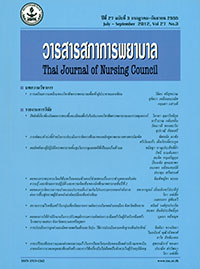การประเมินการถูกล่วงละเมิดทางเพศในเด็กและวัยรุ่น: วิธีการประเมิน ตามหลักฐานเชิงประจักษ์
Keywords:
การประเมินการถูกล่วงละเมิดทางเพศ, เด็กและวัยรุ่น, การพยาบาลตามหลักฐาน เชิงประจักษ์, sexual abuse, children and teenagers, assessment, empirical evidenceAbstract
บทคัดย่อ
การศึกษานี้มีวัตถุประสงค์เพื่อหาแนวทางในการประเมินการถูกล่วงละเมิด ทางเพศในเด็กและวัยรุ่นเพื่อการคัดกรองเบื้องต้นโดยการสังเคราะห์หลักฐานเชิงประจักษ์ โดยใช้แนวทางการสืบค้นหลักฐานเชิงประจักษ์ตามกรอบ PICO คำที่ใช้ในการสืบค้นจาก ฐานข้อมูลต่างๆได้แก่ children suspected sexual abuse, children who may have been sexually abused, child sexual abuse; early detection, screening, investigation, instrument; guideline for assessment, early identification of childhood sexual abuse, และ measurement child sexual abuse ผลการสืบค้น ได้หลักฐานเชิงประจักษ์ที่มีคุณภาพจำนวนทั้งหมด 6 เรื่อง เป็นงานวิจัยแบบภาคตัดขวาง 3 เรื่อง งานวิจัยเชิงความสัมพันธ์ 1 เรื่อง case control study 1 เรื่อง และงานวิจัยผสมผสานวิธีการวิจัย จำนวน 1 เรื่อง งานวิจัยทั้ง 6 เรื่องได้ผ่านการ ประเมินคุณภาพของหลักฐานเชิงประจักษ์ แนวโน้มความเป็นไปได้ในการนำผลการวิจัยไปใช้ รวมทั้งระดับความเข้มแข็งของหลักฐานเชิงประจักษ์
ผลของการสังเคราะห์ พบว่า การประเมินการถูกล่วงละเมิดทางเพศในเด็กและวัยรุ่น ที่สำคัญ ได้แก่ การสัมภาษณ์ตัวเด็กและพ่อแม่หรือผู้ปกครองของเด็ก การสังเกต และการ ตรวจร่างกาย โดยมีการประเมินด้านพฤติกรรม จิตใจ อารมณ์ สังคม ความสัมพันธ์ใน ครอบครัว และทักษะของเด็กในการแก้ปัญหา รวมถึงเทคนิคต่างๆที่ควรใช้ในการสัมภาษณ์ และ/หรือการเก็บรวบรวมข้อมูล
ข้อเสนอแนะจากการศึกษาครั้งนี้ คือ ควรนำผลของการศึกษาไปพัฒนาเป็นแนวปฏิบัติ ในการประเมินการถูกล่วงละเมิดทางเพศในเด็กและวัยรุ่นเพื่อการคัดกรองเบื้องต้นและ ควรมีการศึกษานำร่องในหน่วยงานเพื่อปรับปรุงแนวทางการประเมินให้มีคุณภาพยิ่งขึ้น
คำสำคัญ : การประเมินการถูกล่วงละเมิดทางเพศ, เด็กและวัยรุ่น, การพยาบาลตามหลักฐาน เชิงประจักษ์
Abstract
This study aimed to develop guidelines, based on empirical evidence, for assessing sexual abuse in children and teenagers for pre-screening purposes. Based on the PICO Framework, search for empirical evidence in various databases was conducted by these categories: children suspected of being sexually abused; children who may have been sexually abused; child sexual abuse; early detection, screening, investigation and instrument; guideline for assessment; early identification of childhood sexual abuse; and assessment of child sexual abuse.
The search produced six high-quality empirical studies. These studies consisted of three cross-sectional surveys, one relational study, one case-controlled study and one mix-method study. All of these six studies had passed assessment of empirical evidence quality, research outcome application probability and strength of evidence.
After a synthetic process, it was found that the principal methods for assessing sexual abuse in children and teenagers were interviews with the victims or the victims’ parents, observation and physical examination. Also necessary was the evaluation of the victims’ behaviour, mind, emotions, society, family relationships and problem-solving skills. Another important aspect of sexual abuse assessment concerned interview and/ or data-gathering techniques.
Based on this study, it is recommended that the findings be developed into a standard pre-screening procedure for assessing sexual abuse in children and teenagers. Besides, in-house pilot studies are recommended to enhance the quality of sexual abuse assessment.
Keywords : sexual abuse, children and teenagers, assessment, empirical evidence








